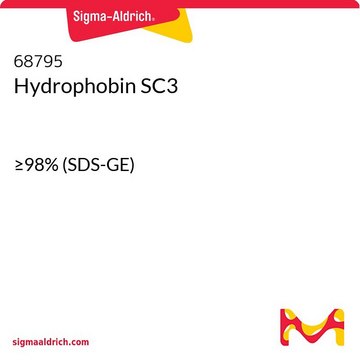81242
Poli(etilenglicole)
tested according to Ph. Eur., 4,000
Sinonimo/i:
PEG
Autenticatiper visualizzare i prezzi riservati alla tua organizzazione & contrattuali
About This Item
Formula condensata:
H(OCH2CH2)nOH
Numero CAS:
Numero MDL:
Codice UNSPSC:
12352104
ID PubChem:
NACRES:
NA.21
Prodotti consigliati
agenzia
tested according to Ph. Eur.
Livello qualitativo
Forma fisica
solid
PM
3500-4500
applicazioni
pharmaceutical (small molecule)
Stringa SMILE
C(CO)O
InChI
1S/C2H6O2/c3-1-2-4/h3-4H,1-2H2
LYCAIKOWRPUZTN-UHFFFAOYSA-N
Cerchi prodotti simili? Visita Guida al confronto tra prodotti
Categorie correlate
Descrizione generale
Poly(ethylene glycol) (PEG) is a non-toxic water-soluble polymer. PEG term is used for the polymer chains with molecular weights below 20 000, while poly(ethylene oxide) (PEO) refers to the higher molecular weight polymers. PEG has various biomedical applications. It forms complexes with α-cyclodextrins. Engineering of PEG hydrogel particles by mesoporous silica (MS) templating method has been reported.
Applicazioni
Poly(ethylene glycol) may be used in the following studies:
- For the modification of proteins to form the conjugates having increased circulating life and reduced immunogenicity and antigenicity.
- Preparation of hydrogels useful for the diffusion controlled delivery of proteins.
- Preparation of poly(ethylene glycol) dimethacrylate (PEGDM).
Codice della classe di stoccaggio
11 - Combustible Solids
Classe di pericolosità dell'acqua (WGK)
WGK 1
Punto d’infiammabilità (°F)
Not applicable
Punto d’infiammabilità (°C)
Not applicable
Dispositivi di protezione individuale
Eyeshields, Gloves, type N95 (US)
Scegli una delle versioni più recenti:
Possiedi già questo prodotto?
I documenti relativi ai prodotti acquistati recentemente sono disponibili nell’Archivio dei documenti.
I clienti hanno visto anche
The clinical efficacy of poly (ethylene glycol)-modified proteins.
Fuertges F and Abuchowski A.
Journal of Controlled Release : Official Journal of the Controlled Release Society, 11(1), 139-148 (1990)
N A Peppas et al.
Journal of controlled release : official journal of the Controlled Release Society, 62(1-2), 81-87 (1999-10-16)
The use of hydrogels as carriers for protein delivery has been a subject of significant recent research. In our recent work, we have shown that diffusion controlled delivery of proteins from hydrogels containing poly(ethylene glycol) (PEG) can be possible and
Stephanie J Bryant et al.
Annals of biomedical engineering, 32(3), 407-417 (2004-04-21)
In approaches to tissue engineer articular cartilage, an important consideration for in situ forming cell carriers is the impact of mechanical loading on the cell composite structure and function. Photopolymerized hydrogel scaffolds based on poly(ethylene glycol) (PEG) may be synthesized
Complex formation between poly (ethylene glycol) and α-cyclodextrin.
Harada A and Kamachi M.
Macromolecules, 23(10), 2821-2823 (1990)
Idalis Villanueva et al.
Acta biomaterialia, 5(8), 2832-2846 (2009-06-11)
The pericellular matrix (PCM) surrounding chondrocytes is thought to play an important role in transmitting biochemical and biomechanical signals to the cells, which regulates many cellular functions including tissue homeostasis. To better understand chondrocytes interactions with their PCM, three-dimensional poly(ethylene
Il team dei nostri ricercatori vanta grande esperienza in tutte le aree della ricerca quali Life Science, scienza dei materiali, sintesi chimica, cromatografia, discipline analitiche, ecc..
Contatta l'Assistenza Tecnica.


